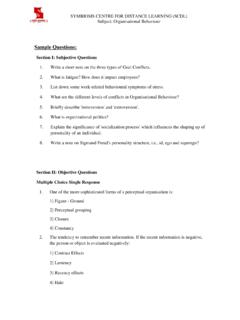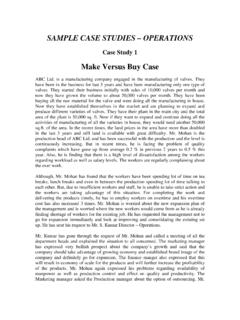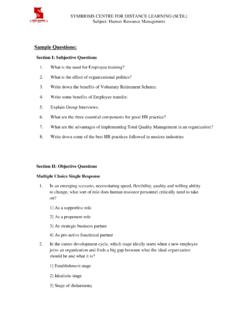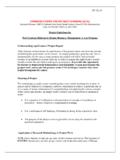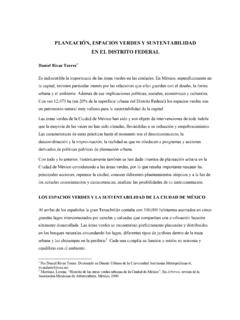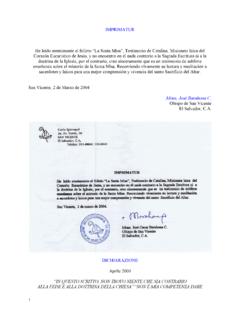Transcription of ODL as a Tool for Women Empowerment: …
1 ODL as a Tool for Women empowerment : reflections from national institute of Open Schooling, India. By Dr Mamta Srivastava Deputy Director (Vocational Education) national institute of Open Schooling India or India is the second most populous country in the whole world. Women comprise which is nearly half of the population of India as per the Ministry of Statistics & Programme Implementation, Statistical Year Book India 2015. The world economic forum on India says that 51% of Women and 75% of men are literate. However the Women participation in job market is quite low. Women s participation in development is very essential not only for achieving social justice but also reducing poverty. Women participation and empowerment are fundamental Women 's rights to enable Women to have control over their lives and put forth influence in society. Education has been regarded as the most significant instrument for changing Women 's position in the society.
2 It not only develops the personality and rationality of individuals, but qualifies them to fulfill certain economic, political and cultural functions and thereby improves their socio-economic status. Education can be an effective tool for Women s empowerment . Open and Distance Education (ODE) mode of learning has emerged as a powerful instrument for augmenting opportunities in the field of education and vocational education, especially for Women in developing countries. Skills development is a key to improving household productivity, employability and income-earning opportunities for all but especially for the Women it leads to improvement of self esteem leading to sustainable development and livelihoods. national institute of Open Schooling (NIOS) an autonomous organisation under Ministry of Human Resource Development caters to the need of school dropouts and offers wide variety of programmes from academic to vocational and skill development.
3 The popularity of NIOS Vocational Education Programmes can be gauged from its impressive growth in the last five years with a cumulative student strength of about 1, 44,871 of which nearly 60 % are Women . Distance education institutions have the potential to convert Vocational Education in to reality, especially for Women and other disadvantaged learners. Such institutions are, therefore, a boon for the unemployed and Women in India. Through this paper the ODL as a tool for empowerment will be highlighted and NIOS initiatives towards Women empowerment . Keywords: Women empowerment , Skills development, Vocational Education, Open and Distance Education. Women empowerment is a global issue and is often discussed at various platforms. The issue of Women empowerment was introduced at the International Women conference at Nairobi in 1985. Education is milestone of Women empowerment because it enables them to respond to the challenges, to confront their traditional role and change their life.
4 Women empowerment is an essential element in national development. Since Women constitute half of the population there can be no development unless the needs and interest of Women are fully taken into account. In fact, empowered Women are a nation s strength. Since development means improvement in the living conditions of the society, as a whole, it is logical to expect that this also mean improved status for Women . Accordingly empowerment has become the key solution to many social problems. empowerment of Women is empowerment of family/household and in turn development of a nation of a country. empowerment of Women leads to benefit not only to the individual woman and to Women groups. Education is considered as one of the most important means to empower Women with the knowledge skill and self confidence necessary to participate fully in development process.
5 India is the second most populous country in the whole world. Women comprise which is nearly half of the population of India as per the Ministry of Statistics & Programme Implementation, Statistical Year Book India 2015. Literacy and level of education are considered as basic indicators of the level of development achieved by any society. Literacy is an important means of overall development of individuals enabling them to comprehend their social, political and cultural environment better and respond to it appropriately. Higher levels of education and literacy lead to a greater awareness and also contributes in improvement of economic and social conditions. It acts as a catalyst for social upliftment enhancing the returns on investment made in almost every aspect of development effort, be it population control, health, hygiene, environmental degradation control, employment of weaker sections of the society etc.
6 While the overall literacy rate works out to be %, the male literacy rate is and that for females is , showing a gap of percentage points between the sexes at the national level. The gap is more in the rural areas. In the urban areas, higher literacy rate has been recorded both for males and females. Though education is important for every individual living on this earth, but it is more significant for Women . Educating girls is not only important because it gives them an opportunity to earn but the most important reason of educating Women is because they are the one who develop the whole family. No doubt, an educated woman can support her family in managing the budget as well as helping them save some money for future. Thus educating a woman is actually providing her with a weapon to live up her customary part, fight with the challenges and bring positive change in her life.
7 It is said that no nation can be a great nation unless and until they have educated and healthy mothers. Therefore it is utmost important to educate a woman because being a mother she is the one who will decide how the future generations will be. The future of a nation is dependent on well-groomed mothers. In the words of Pt Jawaharlal Nehru the first Prime Minister of India if you educate a man you educate an individual ,if you educate a woman you educate a whole family. About NIOS India's national Open School (NOS) was established in 1989 by the Government to reach those who had dropped out of school or never been to school and who wished to study but ,for a variety of reasons not studying in regular schools. Over the years, the role of NOS expanded . In 2002, NOS was re-mandated to act as the national apex body for open schooling, and re-designated as the national institute of Open Schooling (NIOS).
8 NIOS is both a teaching, and an examining and accrediting organization. NIOS can be described as offering an alternative system to formal schooling and is termed as Mega School (Daniel, 2010) with the cumulative enrolment of million students. Every year nearly 5 lakh (0 .50 million )students take admission in various programmes of NIOS. The vast majority of NIOS's secondary school students are out-of-formal-school learners and school drop-outs, working adults, housewives, sports personalities, learners from disadvantaged sectors of society and learners living in remote areas of India. NIOS operates through a network of 20 regional centres, 5 sub-centres, five departments at Head Quarter and more than 6000 accredited Institutions (AIs) and about 1425 Accredited Vocational Institutions (AVIs) in India, Nepal and the Middle East. In NIOS the Academic and Vocational departments serves as the bedrock for all the educational and skill or vocational initiatives that are instrumental in playing and realising the institute s motto of qualitative learning.
9 Both the departments carry forward the vision and mission of NIOS in letter and spirit. The Academic Department encompasses within its operational preview an array of school education segments from pre primary to pre- degree levels. At present it offers secondary and Senior Secondary courses besides the open Basic Education at level A,B,C corresponding to 3, 5 & 8th level of formal system. Whereas the Vocational Department is working in tandem with the national Agenda of Skilling the Youths. It is following the national Skills Qualification framework in implementing the vocational education. NIOS Efforts in empowering Women and girls supporting girls and Women NIOS has wide variety of vocational or skill development courses for girls and Women leading to employment opportunities. The few of the courses are Cutting Tailoring, Beauty Culture, Early Childhood Education, Indian Embroidery, Vermicomposting, Bakery and confectionary etc.
10 Amongst many. The enrollment send in vocational education is Women centre, is 60% of total enrolment is Women . The data for the last 5 yrs is presented in the table below. Year Total Men Women 2015 16 30,990 11299 ( %) 19691 ( %) 2014 15 32472 11840 ( ) 20362 ( %) 2013 14 27020 9888 ( %) 17632 ( %) 2012 13 28035 11158 ( %) 16877 ( %) 2011 12 26354 9972 ( ) 16382 ( ) Table: Enrollment in Vocational Courses ( /statistical report ) Amongst the learners enrolled, the most preferred age group is 14-25 yrs. The young learners came to NIOS for certification which helps in providing skills for self or wage employment. Skills development improves output, quality, diversity and occupational safety and improves health, thereby increasing incomes and livelihoods . Amongst many certified learners are engaged in the wage ,or self employment and supporting their families. Similarly there are numerous sucessful girls/ Women from the academic stream of NIOS who are shining bright ,few of them are ; I.






